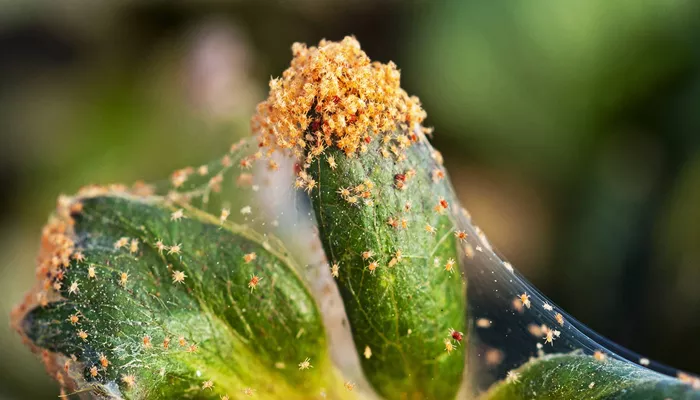Spider mites are one of the most common pests found on plants, and they can cause significant damage if not controlled in time. These tiny creatures are not actually spiders, but they belong to the arachnid family. Despite their small size, they can wreak havoc on plants, especially during dry and hot conditions. Understanding what causes spider mites in plants is essential for gardeners to take preventive measures and protect their beloved plants. In this article, we’ll explore the factors that lead to spider mite infestations, how to spot them, and ways to prevent or manage their spread effectively.
What Are Spider Mites and How Do They Affect Plants?
Spider mites are microscopic pests that can easily go unnoticed until they cause visible damage to your plants. These pests typically infest the underside of leaves and suck the sap, which can weaken plants over time. When the infestation is heavy, it can lead to leaf discoloration, curling, and eventually the death of the plant. Spider mites reproduce quickly, making it crucial to identify and manage the problem as soon as it arises.
Why Do Spider Mites Appear on Plants?
Several factors contribute to spider mite infestations. Some of the most common reasons are:
Dry and Hot Conditions
Spider mites thrive in warm, dry environments. If your garden or indoor plants are in areas with little humidity, they are more likely to be affected. These pests prefer low moisture levels, which is why they are more common in the summer or in areas with high temperatures.
Poor Air Circulation
Good air circulation is important for plant health. Without it, the environment can become stagnant and dry, creating an ideal breeding ground for spider mites. Crowded plants or tightly spaced indoor plants can encourage spider mite infestations.
Nutrient Deficiencies
Plants that are weak due to poor nutrition are more susceptible to pest infestations, including spider mites. If your plants aren’t receiving enough nutrients, they may become stressed, making them a target for these pests.
Lack of Natural Predators
Natural predators such as ladybugs and predatory mites help keep spider mites in check. In environments where these beneficial insects are absent, spider mites can reproduce unchecked.
Overuse of Pesticides
Overusing broad-spectrum pesticides can kill off beneficial insects, allowing spider mites to flourish. Without their natural enemies, spider mites can quickly take over your plants.
How to Prevent Spider Mites in Plants
Prevention is always better than cure when it comes to spider mites. Here are a few ways you can keep them at bay:
Increase Humidity
Since spider mites thrive in dry conditions, increasing the humidity around your plants can help. You can use a humidifier, mist your plants, or group plants together to create a more humid microclimate.
Ensure Proper Watering
Healthy plants are less likely to suffer from spider mite infestations. Make sure your plants are receiving the right amount of water and nutrients. Healthy plants can also recover more quickly if spider mites do appear.
Use Neem Oil or Insecticidal Soap
Natural remedies like neem oil or insecticidal soap can be used to control spider mites. These products are safe for most plants and can be sprayed on affected areas to kill mites without harming the plant.
Introduce Beneficial Insects
Encourage natural predators of spider mites, such as ladybugs, lacewing larvae, or predatory mites, to your garden. These beneficial insects will help keep the spider mite population under control.
Remove Affected Leaves
If you notice spider mites on your plants, remove the affected leaves to prevent the pests from spreading. Be sure to dispose of these leaves properly to avoid reinfestation.
Identifying Spider Mites: Signs and Symptoms
Spider mites can be hard to detect due to their small size, but there are several signs to look for:
Discolored Leaves: Yellow or speckled leaves are a common sign of spider mite damage. The mites suck out the chlorophyll, causing discoloration.
Webbing: Spider mites often leave behind a fine webbing on the underside of leaves, which can be one of the easiest ways to identify them.
Leaf Curling: Affected leaves may curl, distort, or even fall off prematurely.
Conclusion
Spider mites are tiny but destructive pests that can cause significant damage to plants if left unchecked. They thrive in dry, hot conditions and can spread quickly if not managed properly. By understanding the causes and identifying the signs of an infestation early, you can take steps to protect your plants from these pests. With good care, prevention, and natural treatments, you can keep your garden healthy and thriving, free from the damaging effects of spider mites.
5 FAQs About Spider Mites in Plants
1. How do spider mites spread between plants?
Spider mites can spread from plant to plant through wind, direct contact, or even on clothing or tools that have been used on affected plants.
2. What are the best natural remedies for spider mites?
Neem oil, insecticidal soap, and essential oils like peppermint or rosemary oil are effective natural remedies to control spider mites.
3. Can spider mites kill my plants?
Yes, if left untreated, spider mites can weaken the plant significantly, causing it to die, especially if the infestation is severe.
4. How can I tell if my plant has spider mites?
Look for discolored leaves, webbing on the underside of leaves, and signs of leaf curling or distortion.
5. Can spider mites affect indoor plants?
Yes, spider mites can infest indoor plants, especially in dry and warm conditions. Regularly inspect indoor plants for signs of spider mites.


